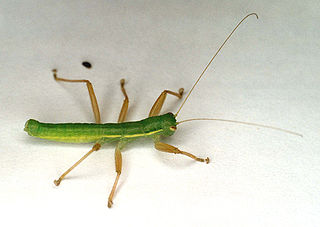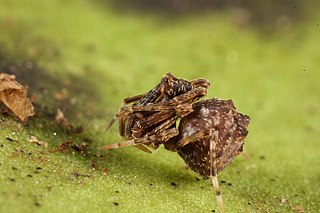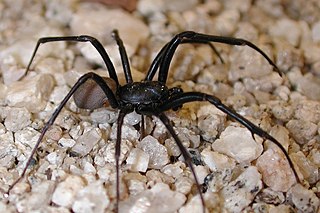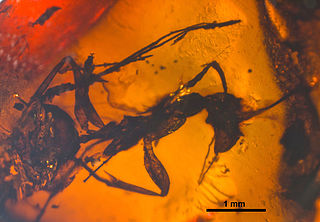
Mantophasmatidae is a family of carnivorous wingless insects within the order Notoptera, which was discovered in Africa in 2001. Originally, the group was regarded as an order in its own right, and named Mantophasmatodea, but, using recent evidence indicating a sister group relationship with Grylloblattidae, Arillo and Engel have combined the two groups into a single order, Notoptera.

Scansoriopteryx is a genus of maniraptoran dinosaur. Described from only a single juvenile fossil specimen found in Liaoning, China, Scansoriopteryx is a sparrow-sized animal that shows adaptations in the foot indicating an arboreal (tree-dwelling) lifestyle. It possessed an unusual, elongated third finger which may have supported a membranous wing, much like the related Yi qi. The type specimen of Scansoriopteryx also contains the fossilized impression of feathers.

Bittacidae is a family of scorpionflies commonly called hangingflies or hanging scorpionflies.

The Stephanidae, sometimes called crown wasps, are a family of parasitoid wasps. They are the only living members of the superfamily Stephanoidea. Stephanidae has at least 345 living species in 11 genera. The family is considered cosmopolitan in distribution, with the highest species concentrations in subtropical and moderate climate zones. Stephanidae also contain four extinct genera described from both compression fossils and inclusions in amber.

Archaeidae, also known as assassin spiders and pelican spiders, is a spider family with about ninety described species in five genera. It contains small spiders, ranging from 2 to 8 millimetres long, that prey exclusively on other spiders. They are unusual in that they have "necks", ranging from long and slender to short and fat. The name "pelican spider" refers to these elongated jaws and necks used to catch their prey. Living species of Archaeidae occur in South Africa, Madagascar and Australia, with the sister family Mecysmaucheniidae occurring in southern South America and New Zealand.

Plectreuridae, also called plectreurid spiders, is a small spider family confined to the Southwestern United States, Mexico, and the Caribbean. Only two living genera are known—the nominate genus Plectreurys and Kibramoa. In the past, the family was more widespread, with the Jurassic genus Eoplectreurys known from China, the Eocene Palaeoplectreurys baltica from Baltic amber and the Miocene Plectreurys pittfieldi from Dominican amber.

The Tiaojishan Formation is a geological formation in Hebei and Liaoning, People's Republic of China, dating to the middle-late Jurassic period. It is known for its exceptionally preserved fossils, including those of plants, insects and vertebrates. It is made up mainly of pyroclastic rock interspersed with basic volcanic and sedimentary rocks. Previously, the Tiaojishan Formation was grouped together with the underlying Haifanggou Formation as a single "Lanqi Formation." The Tiaojishan Formation forms a key part of the Yanliao Biota assemblage.

Pseudosiobla campbelli is an extinct species of sawfly in the family Tenthredinidae that is known from early Eocene Ypresian stage lake deposits near the unincorporated community of Horsefly, British Columbia.
Baltocteniza is an extinct monotypic genus of spider in the family Ctenizidae. At present, it contains the single species Baltocteniza kulickae. The genus is solely known from the Early Eocene Baltic amber deposits in the Baltic Sea region of Europe.
Electrocteniza is an extinct monotypic genus of spider in the family Ctenizidae. At present, it contains the single species Electrocteniza sadilenkoi. The genus is solely known from the Early Eocene Baltic amber deposits in the Baltic Sea region of Europe.
Palaeoperenethis is an extinct monotypic genus of Nursery web spider family Pisauridae, and at present, it contains the single species Palaeoperenethis thaleri. The genus is solely known from the Early Eocene, Ypresian Okanagan Highlands deposits in the Cariboo region of British Columbia, Canada.

Mongolarachne is an extinct genus of spiders placed in the monogeneric family Mongolarachnidae. The genus contains only one species, Mongolarachne jurassica, described in 2013, which is presently the largest fossilized spider on record. The type species was originally described as Nephila jurassica and placed in the living genus Nephila which contains the golden silk orb-weavers.
Mongolbittacus is an extinct genus of hangingfly in the family Bittacidae and containing a single species Mongolbittacus daohugoensis. The species is known only from the Middle Jurassic Jiulongshan Formation, part of the Daohugou Beds, near the village of Daohugou in Ningcheng County, northeastern China.
Protostephanus is an extinct genus of crown wasp in the Hymenoptera family Stephanidae known from an Eocene fossil found in the United States of America. The genus contains a single described species, Protostephanus ashmeadi placed in the stephanid subfamily Stephaninae.

Zherichinius is an extinct genus of ants in the subfamily Dolichoderinae known from fossils found in amber from the Middle Eocene of Sakhalin island Far eastern Russia and Bitterfeld, Germany. At the time of description the species Zherichinius horribilis and Zherichinius rapax were two of eight ant species known from Sakhalin fossils.
This list of fossil arthropods described in 2010 is a list of new taxa of trilobites, fossil insects, crustaceans, arachnids and other fossil arthropods of every kind that have been described during the year 2010. The list only includes taxa at the level of genus or species.

Elephantomyia (Elephantomyia) longirostris is an extinct species of crane fly in the family Limoniidae. The species is solely known from the Middle Eocene Baltic amber deposits in the Baltic Sea region of Europe. The species is one of six in its genus described from Baltic amber.

Paraneuretus is an extinct genus of formicid in the ant subfamily Aneuretinae known from fossils found in Asia and Europe. The genus contains three middle to late Eocene age species, Paraneuretus dubovikoffi, Paraneuretus longicornis, and Paraneuretus tornquisti.

Seppo is an extinct genus of spiders, possibly of the superfamily Palpimanoidea, that lived about 180 million years ago, in the Early Jurassic of what is now Europe. The sole species Seppo koponeni is known from a single fossil from Grimmen, Germany. With the scorpion Liassoscorpionides, it is one of the two only known arachnids from the Lower Jurassic of Germany. Seppo is the first unequivocal Early Jurassic spider, and was recovered from the Green Series member of the Toarcian Ciechocinek Formation.
"Mongolarachne" chaoyangensis is a dubious species of crayfish discovered in the Dawangzhangzi Beds of the Yixian Formation in China, known from a single, poorly preserved specimen, that may be one of, if not, the oldest known fossil crayfish to date. If it were to be properly described as a new species, the genus name would have to be changed since it is preoccupied by an extinct spider.












